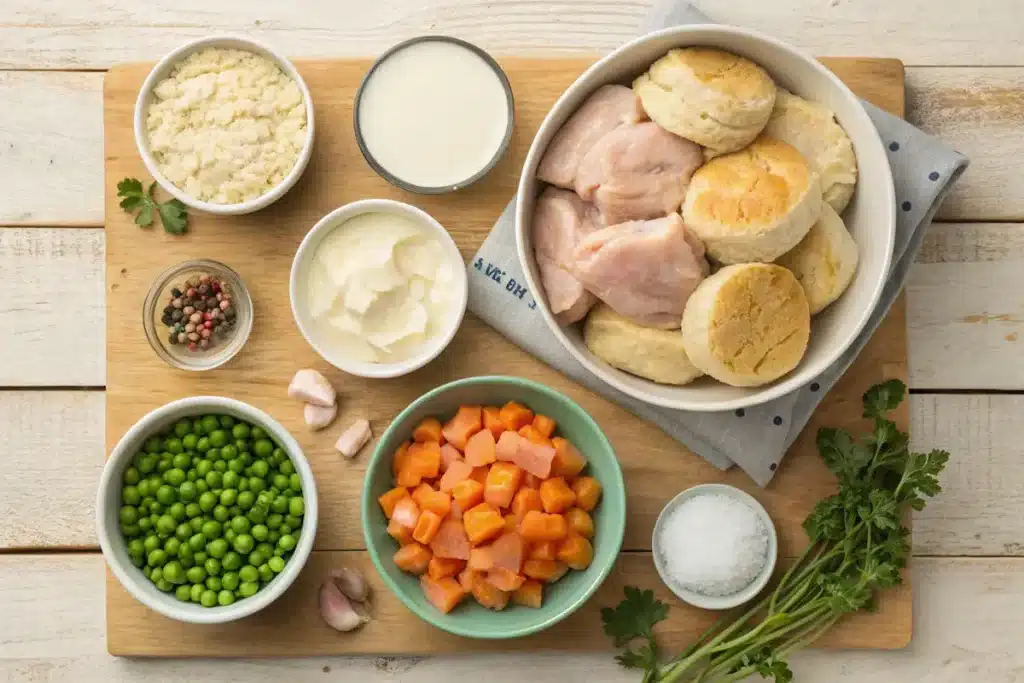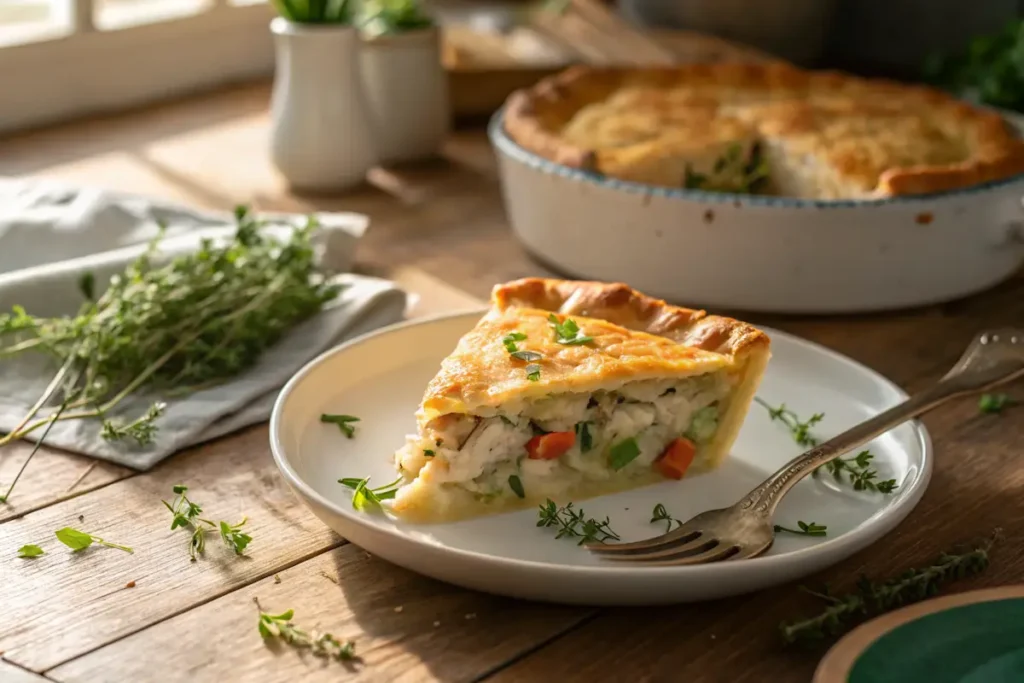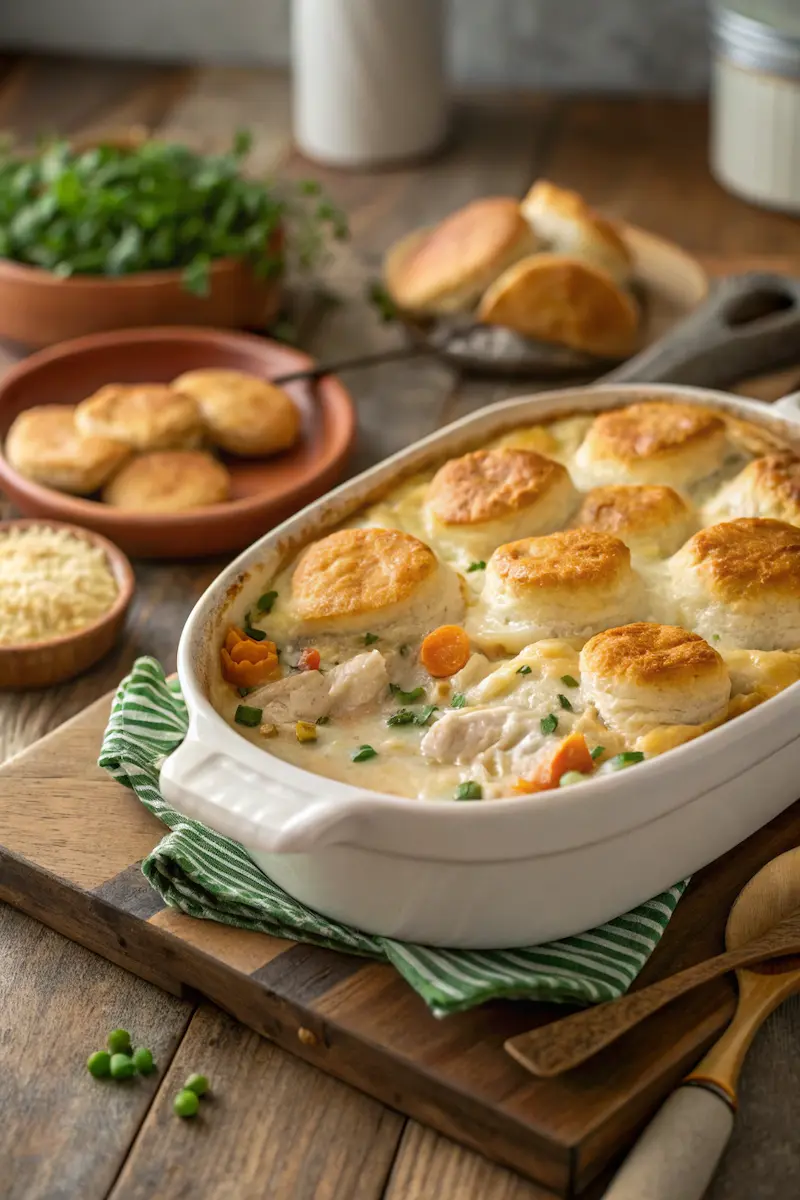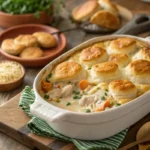Out here on the Miller farm, where the wind hums through the trees and supper brings everyone home, comfort food isn’t just something we eat — it’s a way we stay connected. After long days wrangling livestock or chasing our daughter through muddy pastures, there’s nothin’ better than the smell of something warm bubbling in the oven.
One of our all-time favorites? Chicken pot pie casserole. It’s hearty, easy to throw together, and always hits the spot — especially with a crisp biscuit top and a creamy filling that hugs every bite. Emily says it’s like a hug in a pan. And Lucky, our spotted Dalmatian, waits patiently by the oven the second he smells it.
Today, I’m walkin’ you through how we make it here — farmhouse-style, with a few tricks from my grandma’s old handwritten card and a few modern touches that make it even easier. Whether you’re feedin’ a crowd or just want leftovers worth fightin’ over, this casserole’s got your back.
Why We Love Chicken Pot Pie Casserole at the Farm
A farmhouse tradition made simple
Out here on the Miller homestead, when the sky turns orange and the boots get kicked off by the door, there’s nothin’ more welcome than a casserole dish full of comfort. Emily first made this dish on a cold Monday night after church leftovers ran thin. She didn’t have pie crust, but she sure had leftover chicken, some broth, and a biscuit mix we always keep on hand.
That’s how chicken pot pie casserole became a regular part of our weeknight meals. Now, even our daughter requests it after long school days, and Lucky—our Dalmatian—knows to park himself right by the oven when he smells it warming.
The difference between a pie and a casserole
Jake’s version skips the bottom crust altogether. No rolling pins, no flour clouds on the counter. Instead, it’s a creamy, hearty filling poured into a big ol’ baking dish, topped with golden biscuits. Some nights, we even use puff pastry if we’re feelin’ fancy.
A classic pie might feel more formal, but this casserole is all about ease and comfort. It feeds a crowd, makes the most of leftovers, and brings everyone to the table without fuss. Around here, we say it’s not about perfection—it’s about warmth and flavor.
Table of Contents
How To Make Chicken Pot Pie Casserole– Jake’s Farmhouse Favorite
This creamy, comforting Chicken Pot Pie Casserole is a Miller family favorite, made with tender chicken, garden veggies, and golden biscuit topping. Perfect for weeknights or chilly Sundays, it’s simple to prepare and always brings folks to the table—farmhouse-style.
- Prep Time: 20 minutes
- Cook Time: 30 minutes
- Total Time: 50 minutes
- Yield: 6 servings 1x
- Category: Dinner
- Method: Baked
- Cuisine: Farmhouse Comfort
Ingredients
- 3 cups cooked shredded chicken (leftover or rotisserie works great)
- 1 cup diced carrots
- 1 cup green peas
- 1 cup corn kernels (fresh or frozen)
- 1/2 cup chopped onion
- 2 cloves garlic, minced
- 1/4 cup unsalted butter
- 1/4 cup all-purpose flour
- 2 cups chicken broth
- 1 cup whole milk or heavy cream
- Salt and black pepper, to taste
- 1/2 tsp dried thyme or 1 tsp fresh
- Homemade or store-bought biscuit dough (8–10 biscuits)
- Chopped parsley (optional, for garnish)
Instructions
- Preheat oven to 400°F (200°C). Grease a 9×13-inch casserole dish and set aside.
- In a large skillet or saucepan, melt butter over medium heat. Add chopped onion and garlic, sauté until soft, about 3–4 minutes.
- Whisk in flour and cook for 1–2 minutes until bubbling and lightly golden—this forms your roux.
- Slowly add chicken broth and milk or cream, whisking constantly until smooth. Simmer until thickened, about 5 minutes.
- Stir in cooked chicken, carrots, peas, and corn. Season with salt, pepper, and thyme. Simmer for another 2–3 minutes until heated through.
- Pour the filling into your prepared casserole dish and spread evenly.
- Top with dollops of biscuit dough, spaced slightly apart to allow for rising.
- Bake uncovered for 25–30 minutes, or until biscuits are golden brown and filling is bubbling around the edges.
- Let rest for 5–10 minutes before serving. Garnish with parsley if desired.
Notes
Feel free to swap the chicken for turkey, add mushrooms or spinach for extra veggies, or top with puff pastry for a fancier twist. Biscuits can be homemade or canned—whatever you’ve got on hand will do just fine.
Nutrition
- Serving Size: 1 portion
- Calories: 410
- Sugar: 5g
- Sodium: 520mg
- Fat: 22g
- Saturated Fat: 10g
- Unsaturated Fat: 9g
- Trans Fat: 0g
- Carbohydrates: 30g
- Fiber: 3g
- Protein: 23g
- Cholesterol: 80mg
Ingredients That Matter
Simple staples with big flavor
When it comes to chicken pot pie casserole, Jake always says, “It’s what’s in the pot that counts.” You don’t need a pantry full of fancy items—just the right mix of farmhouse staples. And when we say “right,” we mean ingredients that make your kitchen smell like home.
Here’s what usually goes into Jake’s version:
- Cooked, shredded chicken (leftovers from Sunday roast work just fine)
- A mix of diced carrots, peas, and corn
- Onion and garlic, always fresh
- Chicken broth or stock
- Whole milk or heavy cream for that thick, creamy texture
- Butter and flour for the roux
- And those golden biscuits on top—either from scratch or a trusty can from the store
Fresh vs. frozen veggies: which is best?
We’ll tell you straight—both work just fine. In the summer, we pull fresh peas and carrots right from the garden. But come January, we’re reaching into the freezer without shame. The key is making sure your veggies are cooked until tender but not mushy before they go in the oven.
Biscuit topping choices
Jake’s partial to his homemade drop biscuits—fluffy on the inside, crisp on top. But we’ve also used store-bought biscuit dough and even puff pastry in a pinch. The rule in the Miller kitchen is: use what you’ve got, and make it taste like you meant to.
Step-by-Step – How We Make It at the Farmhouse

Step 1: Start with a good roux
Jake always says the secret to a thick, soul-warming filling starts with the roux. In our cast iron skillet, he melts butter and stirs in flour until it bubbles and smells a little nutty. That’s the sign it’s ready. Don’t rush this part—it’s the foundation of your whole casserole.
Step 2: Add broth and cream, slow and steady
Once the roux’s just right, pour in warm chicken broth and a splash of milk or cream. Stir constantly until it thickens into a smooth, creamy sauce. Jake likes to throw in some garlic and onions here too—sautéed just until soft. He says it “smells like supper’s on its way.”
Step 3: Fold in the fillings
Now’s when it all comes together. Add your cooked chicken and veggies—whatever’s in season or in the freezer. Stir until everything’s coated in that silky sauce. Jake always adds a little salt and pepper to taste and sometimes a pinch of thyme or parsley from the garden.
Step 4: Transfer to a baking dish
Once the filling is creamy and bubbling, pour it into a greased casserole dish. Jake uses his favorite stoneware dish passed down from his mama. “It’s not the dish that matters,” he says, “it’s the hands that fill it.”
Step 5: Biscuit it up
Drop spoonfuls of biscuit dough over the top, or lay out your store-bought dough in a neat little pattern. Jake doesn’t fuss too much—just makes sure they’re spaced enough to puff and brown without sticking together.
Step 6: Bake until golden
Bake at 400°F until those biscuits are golden and the filling is bubbling around the edges—about 25 to 30 minutes. Let it cool just a bit before serving. Around the farmhouse, that’s usually just long enough for Lucky to wander into the kitchen, sniff the air, and wait patiently by Jake’s boots.
Step-by-Step Cooking Before thickening your filling, it’s helpful to see how simple roux-based sauces work in other cozy recipes like this comforting turkey tails recipe—a similar use of slow cooking and bold flavors.
Mistakes to Avoid When Making Chicken Pot Pie Casserole
Overcooking the filling on the stovetop
One of the easiest ways to mess up a good casserole is by overcooking the filling before it even hits the oven. Jake learned that the hard way early on. “If the sauce’s already thick and bubbling before you bake it, you’re gonna dry it out.” Keep it creamy and just warmed through—let the oven finish the job.
Soggy bottoms and biscuit fails
Nobody wants a soggy mess under their biscuit crust. To avoid that, make sure your filling isn’t watery. Simmer it long enough on the stove so it holds its shape when scooped. And don’t forget to leave room between the biscuits so steam can escape—crowding them leads to soggy tops and undercooked bottoms.
Skipping the seasoning
Jake always says, “A bland filling’s a fast way to ruin supper.” Taste your sauce before it goes into the dish. Add salt, pepper, and maybe a dash of garlic or thyme. Just enough to make the flavors sing. Remember, once those biscuits are on, you’re locked in.
Letting it cool too long before serving
It’s tempting to let your casserole sit too long after it comes out of the oven. But let it go cold, and you lose that magic—when the biscuit’s still warm and the filling’s creamy and ready to spoon. Around the Miller table, we say grace, grab our plates, and dig in while the heat’s still clinging to the dish.
Mistakes to Avoid If you’ve ever overcooked your filling or underbaked your topping, don’t worry—it happens. We’ve made those errors with biscuits too, like in this easy biscuit recipe that shows how to get golden tops and tender centers.
Serving Suggestions – What Goes Great with Chicken Pot Pie Casserole

Fresh greens to lighten the plate
Jake’s casserole is rich and hearty, so Emily always puts something fresh and crisp alongside it. A simple garden salad with a light vinaigrette works wonders to balance the creamy filling. Arugula, romaine, or spinach—whatever’s growing out back—gets chopped up and tossed with lemon juice, a drizzle of olive oil, and a pinch of salt.
Roasted or steamed vegetables
On colder days, Jake likes to add roasted carrots or green beans from the freezer. Sometimes they’ll steam broccoli or heat up buttered corn. “You don’t need much,” Jake says. “Just something to add a little color and crunch.”
Jake’s dinner rolls (when there’s no biscuit topping)
If we ever make the casserole without a topping—say, we’re low on dough or want to keep it lighter—Jake pulls out his dinner roll recipe. Hot, fluffy, and best served with butter that melts before it hits the plate. Lucky always hopes one will roll off the counter.
Something sweet to finish the meal
Now, nobody’s got room for a big dessert after a heavy dish like this, but a little something sweet never hurts. Emily’s known for her mini apple crisps or just a few shortbread cookies with coffee. “Doesn’t need to be fancy,” she says. “Just enough to end the day sweet.
Storing Leftovers the Miller Way
Cool it before the lid goes on
Out here, Jake’s rule is simple: don’t rush your casserole into the fridge. “You seal up hot food, you trap steam. Steam turns into soggy biscuits.” After supper, he lets the dish cool on the counter for 20–30 minutes while they clean up and Lucky handles the floor crumbs.
The best way to store it
Once cooled, they scoop leftovers into airtight containers. If it’s a big batch, they layer parchment between pieces to keep the biscuits from sticking together. Stored in the fridge, it stays good for 3–4 days.
Jake says the next-day flavor is even better — especially if you reheat it right.
Reheating without ruining the crust
Microwaves are quick, but they can turn a crispy biscuit into a sad, chewy mess. Jake likes to use the oven or toaster oven instead. He preheats to 350°F, covers the casserole loosely with foil, and warms it for about 20 minutes. For a crisp top, he takes off the foil in the last 5 minutes.
If he’s short on time and uses the microwave, he pops the biscuit top off first, warms the filling separately, then adds the biscuit back on at the end. “A little extra work, but worth every bite.
Storage & Leftovers Storing leftovers right is key to keeping that farmhouse flavor. You can use similar preservation tips like those shown in our frozen cherry vanilla cola dessert—a guide in keeping taste locked in after chilling.
Make It Lighter Without Losing Flavor
Swapping cream for milk (and not missing it)
Jake’s no stranger to rich food, but every now and then Emily reminds him not every meal needs to stick to your ribs like a fence post. So when they’re keeping it lighter, they’ll swap the heavy cream with whole milk or even a mix of low-fat milk and Greek yogurt. “Still creamy,” Jake says, “just a little friendlier on the waistline.”
More veggies, less meat
On days when they don’t have much chicken left or just want to stretch what they’ve got, Emily’ll bulk up the filling with extra carrots, celery, and peas—or even add some sautéed mushrooms or spinach. “We’ve made it without meat a few times and nobody even noticed,” Jake laughs.
Skipping the biscuit — or making it better
Sometimes they’ll skip the biscuit topping altogether and serve the creamy filling over mashed cauliflower or brown rice instead. Other times, Emily mixes whole wheat flour into the biscuit dough or uses almond milk for a dairy-light version.
Jake still prefers his buttery biscuits, but he admits, “when Emily lightens it up, I don’t complain—not if there’s still flavor in the fork.”
Controlling portions, farmhouse-style
Rather than diving into a heaping plate, they serve it in small bowls and pair it with a salad or roasted veggies. “You don’t need a mountain of food to feel full,” Jake says. “You just need a meal made with care.
Jake’s Variations on the Classic
Turkey pot pie casserole (a post-holiday tradition)
After Thanksgiving, you’ll always find leftover turkey in the Miller fridge—and Jake knows exactly what to do with it. He swaps the chicken for shredded turkey, adds leftover green beans or corn, and mixes in a splash of gravy if there’s any left. “Tastes just like the holiday all over again,” he says, “without all the dishes.”
Mini pot pie casseroles for the little one (and lucky guests)
Emily sometimes bakes the casserole in individual ramekins. It’s a hit with their daughter, who loves having her “own pie,” and it makes a pretty fine dish for guests, too. Jake jokes that Lucky always sits by the smallest dish first, thinking it’ll drop easier.
Crispy puff pastry topper (for when you’re feelin’ fancy)
When Emily wants to impress—or just change things up—she’ll use puff pastry instead of biscuits. She cuts it to fit the top of the dish, brushes it with egg wash, and bakes until golden and flaky. Jake says it “tastes like the fancy side of the farmhouse.”
Skillet-style for quick cleanup
On busy nights, Jake skips the casserole dish altogether and cooks the whole thing in a cast iron skillet—from stovetop to oven. Fewer dishes, same great flavor. “One pan, full belly,” he says. “Hard to argue with that.
Why This Dish Keeps Coming Back to Our Table
It’s comforting, no matter the season
Whether there’s snow falling on the pasture or wildflowers blooming along the fence line, chicken pot pie casserole just fits. Jake says it’s one of those meals that never feels out of place. “Cold weather, warm weather, tough days or celebrations—it brings folks to the table every time.”
It uses what we’ve got
Leftover roast chicken? A few lonely carrots? Half a bag of frozen peas? That’s all it takes. Around here, we don’t let food go to waste. And this casserole is proof that with a little know-how and a pinch of creativity, pantry staples can turn into something special.
It feeds the soul, not just the stomach
Jake’s daughter always asks for seconds, Emily hums while she’s baking the biscuits, and Lucky’s tail thumps the moment he hears the oven door crack open. “It’s more than just supper,” Jake says. “It’s a reminder that we’re safe, we’re fed, and we’re together.”
That’s why, no matter what else is cookin’, this dish always comes back around.
FAQs: Answers to Your Chicken Pot Pie Casserole Questions
What is the sauce made of in chicken pot pie?
The sauce is typically a creamy mixture made from butter, flour (to form a roux), chicken broth, and milk or cream. Jake simmers it until thick and velvety before adding in the shredded chicken and vegetables. It’s what gives the dish that signature comfort-in-a-spoon feel.
What are the ingredients in pot pie?
A traditional pot pie includes cooked chicken or turkey, a medley of vegetables like peas, carrots, and corn, and a creamy sauce made from broth and milk. It’s usually topped with a crust—either pie crust, biscuits, or puff pastry—and baked until golden and bubbly.
What is the difference between a pot pie and a casserole?
A pot pie is typically baked in a pie dish and has a bottom and/or top crust. A casserole skips the bottom crust and is usually baked in a large baking dish with toppings like biscuits or cheese. Jake’s chicken pot pie casserole is a farmhouse hybrid—rich and creamy like a pie, but as simple and hearty as a casserole.
What is the difference between chicken pie and chicken pot pie?
Chicken pie often refers to a drier filling with more structure, sometimes without vegetables or sauce. Chicken pot pie is creamier, loaded with vegetables, and features a saucy base under its crust. Around the Miller farm, pot pie means gravy, veggies, and a biscuit top—and lots of seconds.
Conclusion: Why Chicken Pot Pie Casserole Will Always Have a Place at the Farmhouse Table
Chicken pot pie casserole isn’t just one of Jake’s go-to meals—it’s a whole feeling. It’s the smell of garlic and butter drifting through the kitchen while Lucky naps by the door. It’s Emily’s biscuits rising golden on top of a bubbling dish. It’s their daughter’s excited clatter of setting the table because “Dad’s making the good one tonight.”
Out on the Miller farm, meals like this are more than a way to fill your belly. They’re how we pause, gather, and remind ourselves of what really matters—good food, shared stories, and a full table at the end of a long day.
And that’s what makes a dish like this worth making again and again. It’s simple. It’s forgiving. And it always brings a little bit of comfort to every bite.
So next time you’ve got a handful of leftover chicken and a house that needs warming, don’t overthink it. Jake would tell you: make the casserole.
Because some meals don’t just feed you—they bring you home.



